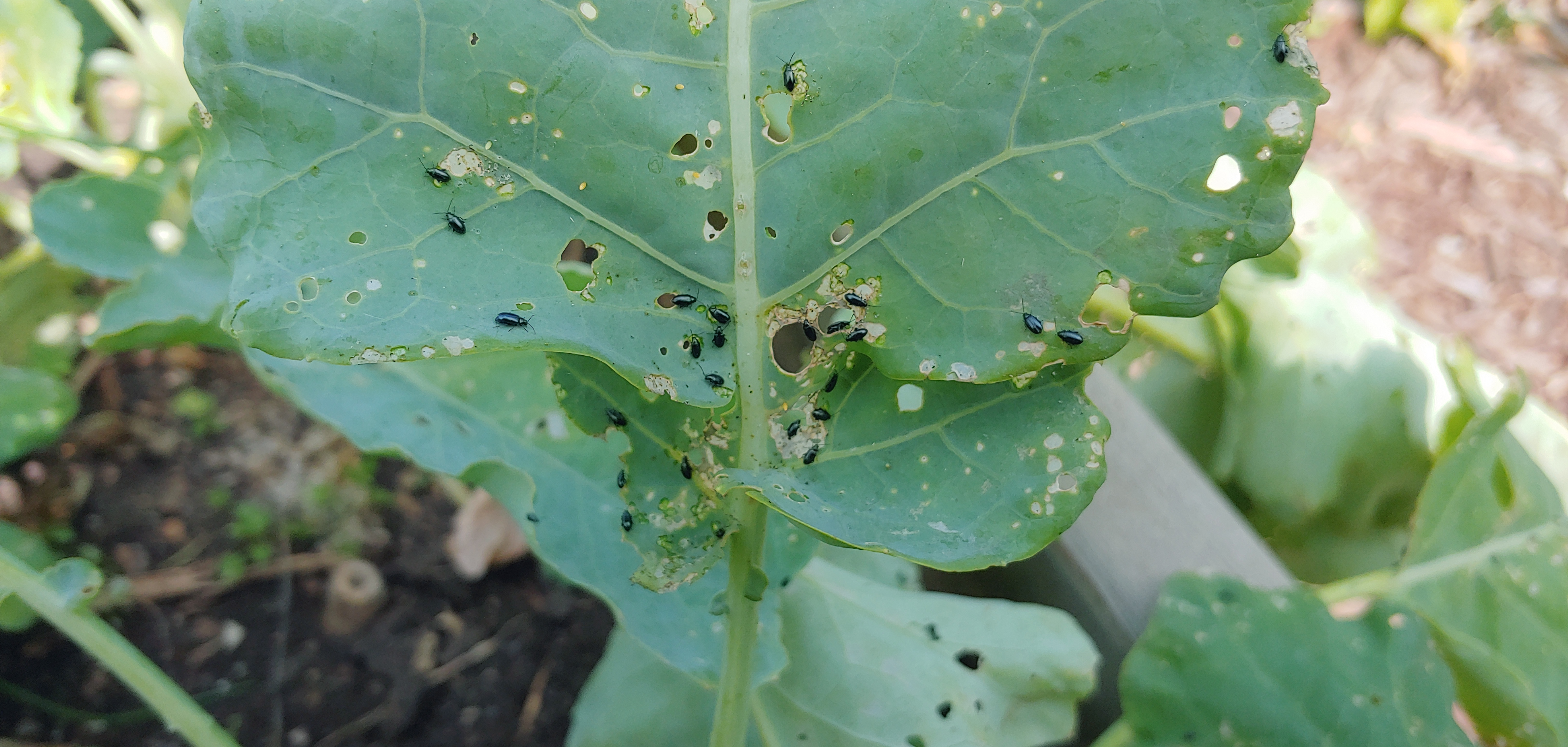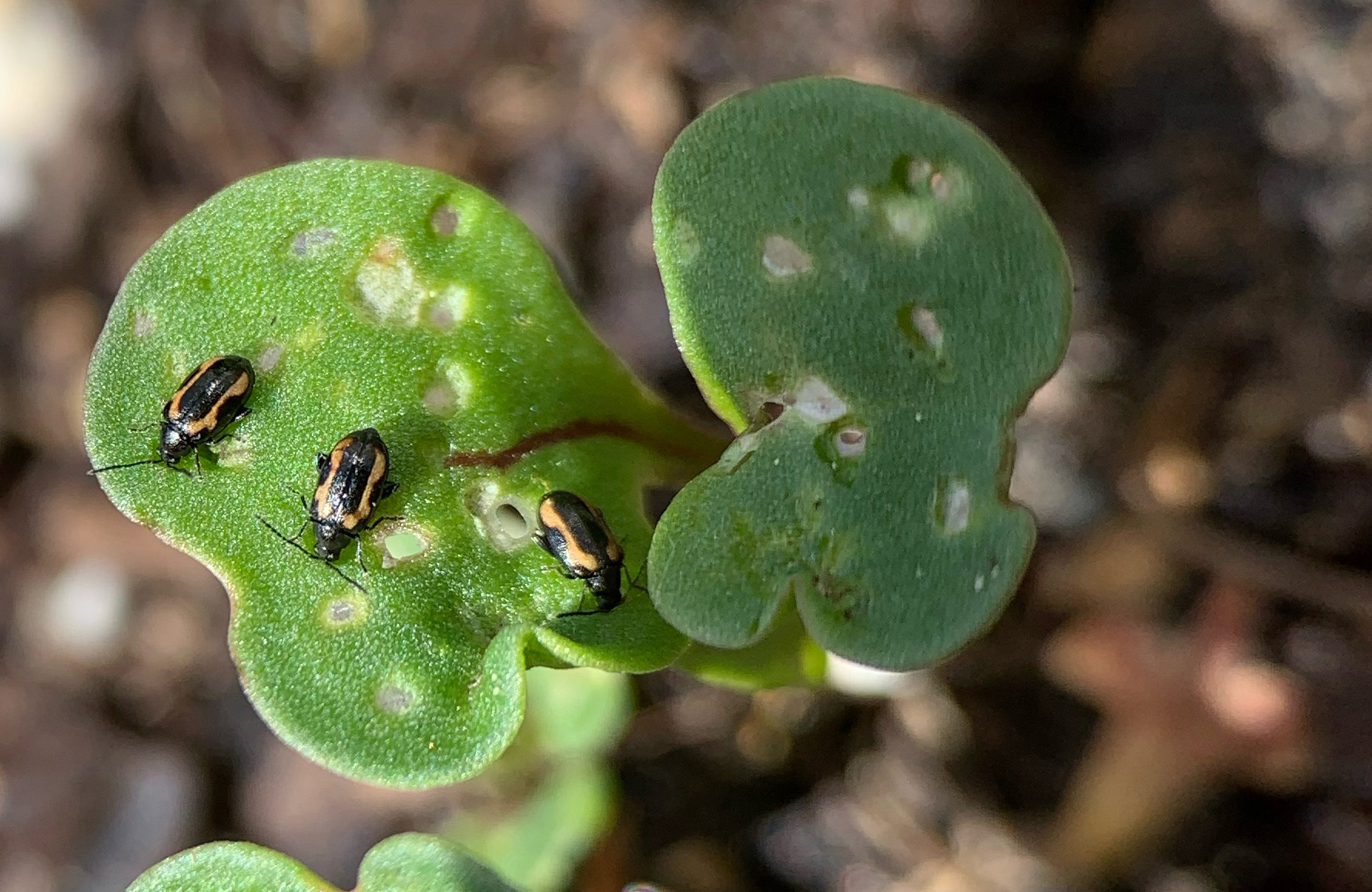
Flea beetle
Nuisance

There are two species of flea beetles of concern to the home vegetable gardener.
The striped flea beetle (Phyllotreta striolata) and the crucifer flea beetle (Phyllotreta cruciferae). Both are only 1 mm long, shiny hard beetles that jump like a flea when disturbed. The striped flea beetle is black with two wavy yellow markings on its back, while the crucifer flea beetle is all black. Adults do all of the damage to plants, by feeding on the underside of leaves creating small pits or irregularly shaped holes.
Flea beetles feed on many different vegetables including: cabbage, cauliflower, broccoli, Brussels sprouts, kohrabi, kale, radish, pak choi, potato, tomato, eggplant, arugula, beets and spinach. They also feed on nasturtium, alyssum and horseradish. Any weeds in the mustard family are hosts to flea beetles, such as: shepherd's purse, stinkweed, common pepper-grass and any of the wild mustards or canola.
Damage from flea beetles is worst at the cotyledon or seed leaf stage. Older plants can tolerate feeding with less damage.
Life cycle:
Adult beetles over-winter under debris in the garden and in sheltered areas. In late May, adults emerge and lay eggs on plants. The developing young chew small holes in the cotyledons (seed leaves) as well as mature leaves. There are two generations per year.
Control:
- If possible, plant transplants instead of direct seeding, which are more vulnerable. If direct seeding, sow seeds more thickly. Close planting promotes shade which flea beetles to do not like.
- Plant out transplants after the spring infestation of flea beetle has finished.
- Sow early trap crops of mustard or arugula two weeks earlier than the direct seeded plants emerge or transplants are planted. Place trap crops at least 3 m away from your main crop. Destroy trap plants and the flea beetles after infestation.
- Keep plants well-watered as stressed plants are more vulnerable to attack.
- Flea beetles prefer it hot and dry. Apply overhead water during the heat of the day to discourage them.
- Cover newly seeded areas or young transplants with floating row covers to prevent attacks. Be sure to secure the edges with soil or heavy objects to prevent flea beetles from getting inside.
- Keep weeds picked, especially those in the mustard family.
- Choose varieties of brassicas with a thick waxy bloom on their foliage which tends to resist flea beetle damage:
- Cabbage: 'Copenhagen market', 'Early Jersey wakefield', 'Ferry's Round Dutch', 'Mammoth red rock'
- Broccoli: 'Atlantic', 'Coastal', 'Gem', 'Italian green sprouting'
- Cauliflower: 'Early snowball'
- Radish: 'Champion', 'Sparkler'
- A vacuum is an effective way to reduce the number of insects on unprotected plants. If you have a wet/dry shopvac, place 1 cm of water in the canister and vacuum up the insects with a soft brush attachment. The water will help drown some of the insects and make clean up easier. Once you're done
vacuuming , leave the vacuum in the hot sun for a while to kill off the remaining insects.
Sources:
Philip, H. G. (2018). Field crop and forage pests and their natural enemies in Western Canada: Identification and management. Saskatoon, Saskatchewan: Agriculture and Agri-Food Canada.
Williams, S.; Skinner, H. (2011). Gardening, naturally: A chemical-free handbook for the Prairies. Regina, Saskatchewan: Coteau Books.

